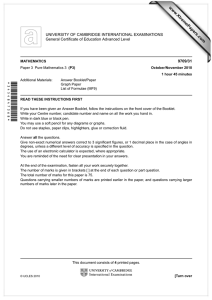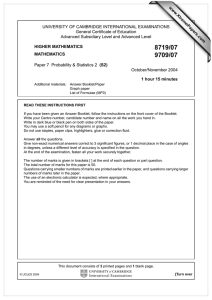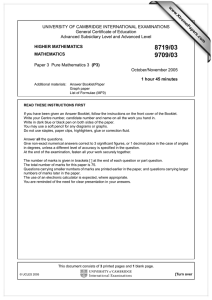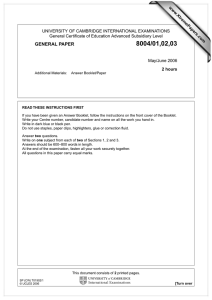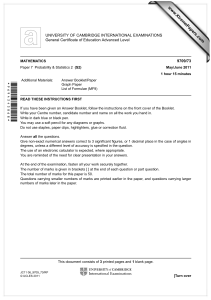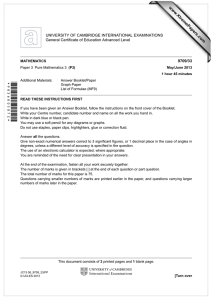www.XtremePapers.com
advertisement
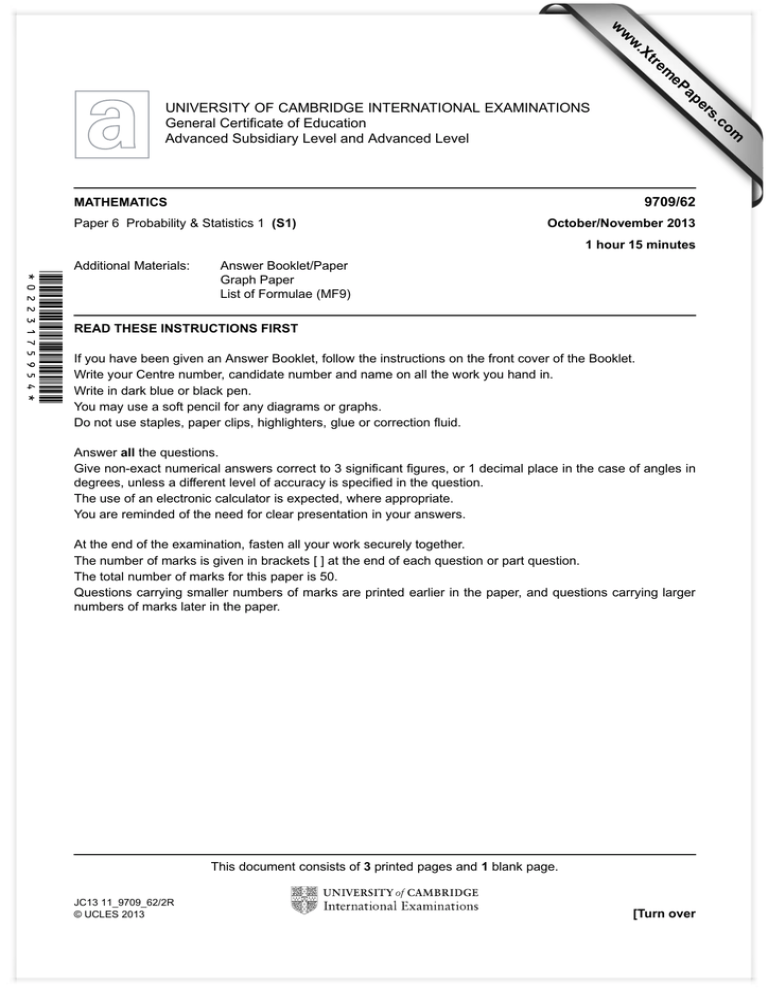
w w ap eP m e tr .X w om .c s er UNIVERSITY OF CAMBRIDGE INTERNATIONAL EXAMINATIONS General Certificate of Education Advanced Subsidiary Level and Advanced Level 9709/62 MATHEMATICS Paper 6 Probability & Statistics 1 (S1) October/November 2013 1 hour 15 minutes *0223175954* Additional Materials: Answer Booklet/Paper Graph Paper List of Formulae (MF9) READ THESE INSTRUCTIONS FIRST If you have been given an Answer Booklet, follow the instructions on the front cover of the Booklet. Write your Centre number, candidate number and name on all the work you hand in. Write in dark blue or black pen. You may use a soft pencil for any diagrams or graphs. Do not use staples, paper clips, highlighters, glue or correction fluid. Answer all the questions. Give non-exact numerical answers correct to 3 significant figures, or 1 decimal place in the case of angles in degrees, unless a different level of accuracy is specified in the question. The use of an electronic calculator is expected, where appropriate. You are reminded of the need for clear presentation in your answers. At the end of the examination, fasten all your work securely together. The number of marks is given in brackets [ ] at the end of each question or part question. The total number of marks for this paper is 50. Questions carrying smaller numbers of marks are printed earlier in the paper, and questions carrying larger numbers of marks later in the paper. This document consists of 3 printed pages and 1 blank page. JC13 11_9709_62/2R © UCLES 2013 [Turn over 2 1 It is given that X ∼ N 1.5, 3.22 . Find the probability that a randomly chosen value of X is less than −2.4. [3] 2 On Saturday afternoons Mohit goes shopping with probability 0.25, or goes to the cinema with probability 0.35 or stays at home. If he goes shopping the probability that he spends more than $50 is 0.7. If he goes to the cinema the probability that he spends more than $50 is 0.8. If he stays at home he spends $10 on a pizza. 3 (i) Find the probability that Mohit will go to the cinema and spend less than $50. [1] (ii) Given that he spends less than $50, find the probability that he went to the cinema. [4] The amount of fibre in a packet of a certain brand of cereal is normally distributed with mean 160 grams. 19% of packets of cereal contain more than 190 grams of fibre. (i) Find the standard deviation of the amount of fibre in a packet. [3] (ii) Kate buys 12 packets of cereal. Find the probability that at least 1 of the packets contains more than 190 grams of fibre. [2] 4 The following histogram summarises the times, in minutes, taken by 190 people to complete a race. Frequency density 2.0 1.8 1.6 1.4 1.2 1.0 0.8 0.6 0.4 0.2 0 100 200 300 400 Time in minutes (i) Show that 75 people took between 200 and 250 minutes to complete the race. [1] (ii) Calculate estimates of the mean and standard deviation of the times of the 190 people. [6] (iii) Explain why your answers to part (ii) are estimates. [1] © UCLES 2013 9709/62/O/N/13 3 5 On trains in the morning rush hour, each person is either a student with probability 0.36, or an office worker with probability 0.22, or a shop assistant with probability 0.29 or none of these. (i) 8 people on a morning rush hour train are chosen at random. Find the probability that between 4 and 6 inclusive are office workers. [3] (ii) 300 people on a morning rush hour train are chosen at random. Find the probability that between 31 and 49 inclusive are neither students nor office workers nor shop assistants. [6] 6 The 11 letters of the word REMEMBRANCE are arranged in a line. (i) Find the number of different arrangements if there are no restrictions. [1] (ii) Find the number of different arrangements which start and finish with the letter M. [2] (iii) Find the number of different arrangements which do not have all 4 vowels (E, E, A, E) next to each other. [3] 4 letters from the letters of the word REMEMBRANCE are chosen. (iv) Find the number of different selections which contain no Ms and no Rs and at least 2 Es. 7 [3] Rory has 10 cards. Four of the cards have a 3 printed on them and six of the cards have a 4 printed on them. He takes three cards at random, without replacement, and adds up the numbers on the cards. (i) Show that P the sum of the numbers on the three cards is 11 = 12 . [3] (ii) Draw up a probability distribution table for the sum of the numbers on the three cards. [4] Event R is ‘the sum of the numbers on the three cards is 11’. Event S is ‘the number on the first card taken is a 3’. (iii) Determine whether events R and S are independent. Justify your answer. [3] (iv) Determine whether events R and S are exclusive. Justify your answer. [1] © UCLES 2013 9709/62/O/N/13 4 BLANK PAGE Permission to reproduce items where third-party owned material protected by copyright is included has been sought and cleared where possible. Every reasonable effort has been made by the publisher (UCLES) to trace copyright holders, but if any items requiring clearance have unwittingly been included, the publisher will be pleased to make amends at the earliest possible opportunity. University of Cambridge International Examinations is part of the Cambridge Assessment Group. Cambridge Assessment is the brand name of University of Cambridge Local Examinations Syndicate (UCLES), which is itself a department of the University of Cambridge. © UCLES 2013 9709/62/O/N/13



